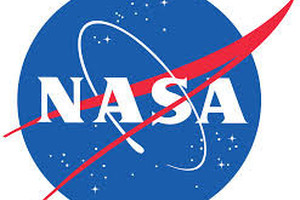
If you remember one fact from this story, make it this: America’s new rocket will be capable of carrying 12 fully grown elephants into orbit.
Before anyone protests about a gross misappropriation of taxpayers’ money, not to mention the associated animal rights issues, this is a purely hypothetical scenario Nasa uses in an attempt to illustrate the sheer scale and power of its new launcher.
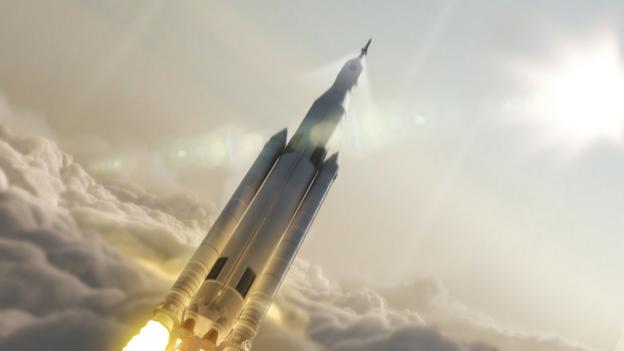
The rocket is expected to make it's first launch in 2018 (Nasa)
The Space Launch System (SLS) will be taller than the Statue of Liberty, weigh more than seven-and-a-half fully loaded Boeing 747s and have more power than 13,400 locomotive engines. All that adds up to a rocket capable of taking humans beyond Earth orbit for the first time since the last Saturn V carried Apollo astronauts to the Moon in 1972.
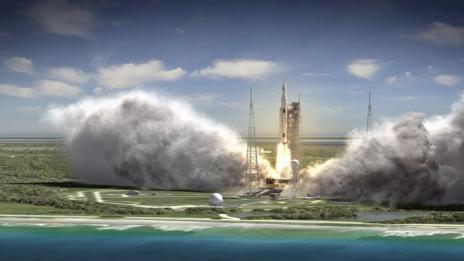
(Nasa)
Giant rockets? Nasa is back in business.
“This will be a unique rocket,” says SLS systems engineer, Dawn Stanley. “It’s going to get us back to the Moon and beyond the Moon to asteroids and Mars, further than we’ve ever gone before.”
Stanley is based at Marshall Spaceflight Center in Huntsville, Alabama, behind the high security fences of the Redstone Arsenal – for more than 60 years the home of America’s missile and rocket programme. The 154 sq kilometre (60 sq mile) site is dotted with firing ranges, test stands and discarded space hardware.
Versatile design
Relics include the precarious-looking scaffold where the first rocket to put an American in space was tested, the thick metal casing for an abandoned nuclear spacecraft and bulbous engines from the Saturn V rocket. Next to the parking lot are discarded Space Shuttle solid rocket boosters, reassuringly painted with the word “empty” on the side.
Conscious of all this history around her, Stanley says the new spacecraft is designed to be more versatile than anything that has gone before.
“If they want us to go to an asteroid to do a retrieval mission, this rocket can get you there or if you want to go to Mars, this rocket can get there,” she says. “The SLS can meet those many missions that our government has.”
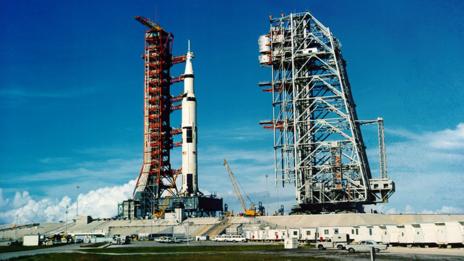
The rocket harks back to the days of the Saturn V, which launched Nasa's Moon missions (Nasa)
The SLS launcher is being built to carry the new Orion crew capsule, first successfully tested – without a crew – in December. Although it is a new design, the rocket employs many technologies from previous Nasa endeavours.
The first four SLS launchers will use spare engines left over from the Space Shuttle programme, the solid rocket boosters are longer versions of the ones used on Shuttle; and the upper stage engine is based on a 1960s Saturn 5 design. Stanley makes no apologies for this rocketry recycling.
“To get off the Earth, we still need a rocket so we’re using Shuttle technology and technology from Apollo but we’re also infusing new technology,” she says. “Our core stage is a new design and we’re using new manufacturing techniques to get an efficient and affordable rocket built.”
Bikes and buggies
The SLS itself is taking shape some six hours drive south of Huntsville in Nasa’s vast Michoud assembly facility near New Orleans. Almost a kilometre long, this factory was used to build the Saturn V rocket and, until, recently the Shuttle’s external fuel tank.
Because of its size most of the workers get around the rocket factory on bicycles or, if they are really lucky, white Austin Powers-style electric buggies – complete with Nasa emblems on the side.
“We have hundreds of bikes we use,” says engineering manager Pat Whipps, as we pass a group of cyclists in our Austin-Powers-style electric buggy. “In fact we used to boast the largest bike repair facility in the southern United States.”
We drive past the first barrels, rings and domes of the new rocket, arranged across the factory floor like some sort of modernistic Stonehenge. Each one is made from sheets of aluminium, only a few millimetres thick in places but given structural integrity by an internal lattice of thicker metal. These gleaming structures will soon be welded together to form the central core of the rocket. This will be filled with fuel tanks, engines and control systems.
“Everything about this programme is big – the tooling is big, the hardware you make is big and yet the tolerances you work to are really small,” says Whipps as we pull up alongside one of the towering robotic welding machines. “You’re looking at thousandths of an inch of accuracy for something that you have to look up and up and up just to see the top of.”
Stirring metal
The technique being used to join all these structures together is called friction stir welding, which literally involves blending the metal together.
“Welding typically uses lots of heat, fire and smoke,” explains SLS engineer Brent Gaddes. “Friction stir welding is totally different because you never completely melt the metal – you actually stir it together. The metal never gets above the melting point.”
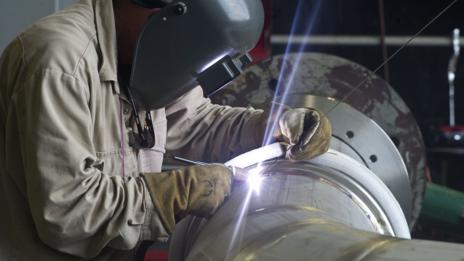
(Nasa)
It’s a remarkable process to watch – two panels are clamped together and a computer-controlled rotating spindle moves along the join. It takes only a few minutes for even the longest welds, which are stronger and more reliable than anything produced using conventional welding techniques.
The most impressive part of the New Orleans factory is undoubtedly the final assembly hall, where the entire central core of the rocket will be put together. This seventeen story high building is filled with a single robotic welding machine, the largest friction stir welding structure ever built.
“This is not the same as something else made larger,” says Whipps. “This is a brand new tool, the likes of which no-one has made before, but the rocket we’re sending is the biggest rocket sent off the face of the Earth and that’s also something we’ve never done before.”
Into the unknown
The first SLS launcher is due for launch in 2018, which means the engineers at Michoud and Marshall have a little over two years to build the first core, test the engines and boosters and ship it round the coast in a barge for final assembly at the Kennedy Space Center in Florida. Not surprisingly, the first mission – to a point further than an astronaut-rated spacecraft has ever gone – will not have a crew on board.
“We’re going to go about 30,000 miles further than the Apollo missions went,” says Stanley. “We have to balance safety with performance – we want to make sure we’re taking the appropriate risk.”
It is a view shared by Whipps, who has pictures on his office wall of the doomed crews of the Challenger and Columbia Shuttle missions. He says everyone at Michoud is conscious that they are building a rocket that will ultimately carry astronauts.

The rocket is expected to be used for any manned missions to Mars (Nasa)
“We often have astronauts and their families visit, which helps remind us that what we’re doing is incredible, a privilege, but it’s dangerous work too,” he says.
With funding in place it is almost certain that, unlike previous rocket programmes, the SLS will fly. Assuming everything checks-out with the rocket and the Orion capsule, the first crew could be on board by the end of the decade. The question then becomes: where will it go?
Politicians are still dithering over what they want Nasa to do with this incredible capability. Will they endorse a return to the Moon, an asteroid (the current favourite) or a more ambitious voyage to Mars? Whatever the White House and Congress chooses, after more than 40 years, America will once again have the means to take humans into deep space.
“Our citizens want the United States to be first,” says Stanley. “We’re a competitive nation and we think we should lead the world in a lot of areas and space is one of them.”
http://www.bbc.com/future/story/20150310-inside-nasas-giant-rocket-lab
